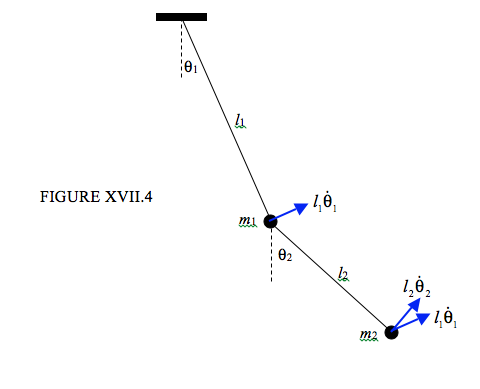17.5: Double Pendulum
- Page ID
- 7041
\( \newcommand{\vecs}[1]{\overset { \scriptstyle \rightharpoonup} {\mathbf{#1}} } \)
\( \newcommand{\vecd}[1]{\overset{-\!-\!\rightharpoonup}{\vphantom{a}\smash {#1}}} \)
\( \newcommand{\dsum}{\displaystyle\sum\limits} \)
\( \newcommand{\dint}{\displaystyle\int\limits} \)
\( \newcommand{\dlim}{\displaystyle\lim\limits} \)
\( \newcommand{\id}{\mathrm{id}}\) \( \newcommand{\Span}{\mathrm{span}}\)
( \newcommand{\kernel}{\mathrm{null}\,}\) \( \newcommand{\range}{\mathrm{range}\,}\)
\( \newcommand{\RealPart}{\mathrm{Re}}\) \( \newcommand{\ImaginaryPart}{\mathrm{Im}}\)
\( \newcommand{\Argument}{\mathrm{Arg}}\) \( \newcommand{\norm}[1]{\| #1 \|}\)
\( \newcommand{\inner}[2]{\langle #1, #2 \rangle}\)
\( \newcommand{\Span}{\mathrm{span}}\)
\( \newcommand{\id}{\mathrm{id}}\)
\( \newcommand{\Span}{\mathrm{span}}\)
\( \newcommand{\kernel}{\mathrm{null}\,}\)
\( \newcommand{\range}{\mathrm{range}\,}\)
\( \newcommand{\RealPart}{\mathrm{Re}}\)
\( \newcommand{\ImaginaryPart}{\mathrm{Im}}\)
\( \newcommand{\Argument}{\mathrm{Arg}}\)
\( \newcommand{\norm}[1]{\| #1 \|}\)
\( \newcommand{\inner}[2]{\langle #1, #2 \rangle}\)
\( \newcommand{\Span}{\mathrm{span}}\) \( \newcommand{\AA}{\unicode[.8,0]{x212B}}\)
\( \newcommand{\vectorA}[1]{\vec{#1}} % arrow\)
\( \newcommand{\vectorAt}[1]{\vec{\text{#1}}} % arrow\)
\( \newcommand{\vectorB}[1]{\overset { \scriptstyle \rightharpoonup} {\mathbf{#1}} } \)
\( \newcommand{\vectorC}[1]{\textbf{#1}} \)
\( \newcommand{\vectorD}[1]{\overrightarrow{#1}} \)
\( \newcommand{\vectorDt}[1]{\overrightarrow{\text{#1}}} \)
\( \newcommand{\vectE}[1]{\overset{-\!-\!\rightharpoonup}{\vphantom{a}\smash{\mathbf {#1}}}} \)
\( \newcommand{\vecs}[1]{\overset { \scriptstyle \rightharpoonup} {\mathbf{#1}} } \)
\( \newcommand{\vecd}[1]{\overset{-\!-\!\rightharpoonup}{\vphantom{a}\smash {#1}}} \)
\(\newcommand{\avec}{\mathbf a}\) \(\newcommand{\bvec}{\mathbf b}\) \(\newcommand{\cvec}{\mathbf c}\) \(\newcommand{\dvec}{\mathbf d}\) \(\newcommand{\dtil}{\widetilde{\mathbf d}}\) \(\newcommand{\evec}{\mathbf e}\) \(\newcommand{\fvec}{\mathbf f}\) \(\newcommand{\nvec}{\mathbf n}\) \(\newcommand{\pvec}{\mathbf p}\) \(\newcommand{\qvec}{\mathbf q}\) \(\newcommand{\svec}{\mathbf s}\) \(\newcommand{\tvec}{\mathbf t}\) \(\newcommand{\uvec}{\mathbf u}\) \(\newcommand{\vvec}{\mathbf v}\) \(\newcommand{\wvec}{\mathbf w}\) \(\newcommand{\xvec}{\mathbf x}\) \(\newcommand{\yvec}{\mathbf y}\) \(\newcommand{\zvec}{\mathbf z}\) \(\newcommand{\rvec}{\mathbf r}\) \(\newcommand{\mvec}{\mathbf m}\) \(\newcommand{\zerovec}{\mathbf 0}\) \(\newcommand{\onevec}{\mathbf 1}\) \(\newcommand{\real}{\mathbb R}\) \(\newcommand{\twovec}[2]{\left[\begin{array}{r}#1 \\ #2 \end{array}\right]}\) \(\newcommand{\ctwovec}[2]{\left[\begin{array}{c}#1 \\ #2 \end{array}\right]}\) \(\newcommand{\threevec}[3]{\left[\begin{array}{r}#1 \\ #2 \\ #3 \end{array}\right]}\) \(\newcommand{\cthreevec}[3]{\left[\begin{array}{c}#1 \\ #2 \\ #3 \end{array}\right]}\) \(\newcommand{\fourvec}[4]{\left[\begin{array}{r}#1 \\ #2 \\ #3 \\ #4 \end{array}\right]}\) \(\newcommand{\cfourvec}[4]{\left[\begin{array}{c}#1 \\ #2 \\ #3 \\ #4 \end{array}\right]}\) \(\newcommand{\fivevec}[5]{\left[\begin{array}{r}#1 \\ #2 \\ #3 \\ #4 \\ #5 \\ \end{array}\right]}\) \(\newcommand{\cfivevec}[5]{\left[\begin{array}{c}#1 \\ #2 \\ #3 \\ #4 \\ #5 \\ \end{array}\right]}\) \(\newcommand{\mattwo}[4]{\left[\begin{array}{rr}#1 \amp #2 \\ #3 \amp #4 \\ \end{array}\right]}\) \(\newcommand{\laspan}[1]{\text{Span}\{#1\}}\) \(\newcommand{\bcal}{\cal B}\) \(\newcommand{\ccal}{\cal C}\) \(\newcommand{\scal}{\cal S}\) \(\newcommand{\wcal}{\cal W}\) \(\newcommand{\ecal}{\cal E}\) \(\newcommand{\coords}[2]{\left\{#1\right\}_{#2}}\) \(\newcommand{\gray}[1]{\color{gray}{#1}}\) \(\newcommand{\lgray}[1]{\color{lightgray}{#1}}\) \(\newcommand{\rank}{\operatorname{rank}}\) \(\newcommand{\row}{\text{Row}}\) \(\newcommand{\col}{\text{Col}}\) \(\renewcommand{\row}{\text{Row}}\) \(\newcommand{\nul}{\text{Nul}}\) \(\newcommand{\var}{\text{Var}}\) \(\newcommand{\corr}{\text{corr}}\) \(\newcommand{\len}[1]{\left|#1\right|}\) \(\newcommand{\bbar}{\overline{\bvec}}\) \(\newcommand{\bhat}{\widehat{\bvec}}\) \(\newcommand{\bperp}{\bvec^\perp}\) \(\newcommand{\xhat}{\widehat{\xvec}}\) \(\newcommand{\vhat}{\widehat{\vvec}}\) \(\newcommand{\uhat}{\widehat{\uvec}}\) \(\newcommand{\what}{\widehat{\wvec}}\) \(\newcommand{\Sighat}{\widehat{\Sigma}}\) \(\newcommand{\lt}{<}\) \(\newcommand{\gt}{>}\) \(\newcommand{\amp}{&}\) \(\definecolor{fillinmathshade}{gray}{0.9}\)This is another similar problem, though, instead of assuming Hooke’s law, we shall assume that angles are small ( \( \sin \theta \approx \theta , \cos \theta \approx 1 - \frac{1}{2} \theta^2\) ). For clarity of drawing, however, I have drawn large angles in Figure XVIII.4.

Because I am going to use the lagrangian equations of motion, I have not marked in the forces and accelerations; rather, I have marked in the velocities. I hope that the two components of the velocity of \(m_{2} \) that I have marked are self-explanatory; the speed of \(m_{2} \) is given by \( v^2_{2} = l^2_{1}\dot{\theta}^2_{1} + l^2_{2}\dot{\theta}^2_{2} + 2 l_{1}l_{2}\dot{\theta}_1 \dot{\theta}_2 \cos(\theta_2- \theta_1) \). The kinetic and potential energies are
\[ T = \frac{1}{2}m_1l^2_1\dot{\theta}^2_1 + \frac{1}{2}m_1
[l^2_1\dot{\theta}^2_1 + l^2_2\dot{\theta}^2_2 + 2l_1l_2\dot{\theta}_1\dot{\theta}_2 \cos(\theta_2 - \theta_1)], \label{17.5.1} \]
\[ V = constant - m_1gl_1 \cos \theta_1 - m_2g(l_1\cos \theta_1 + l_2 \cos \theta_2). \label{17.5.2} \]
If we now make the small angle approximation, these become
\[ T = \frac{1}{2} m_1l^2_1 \dot{\theta}^2_1 + \frac{1}{2} m_2(l_1 \dot{\theta}_1 + l_2 \dot{\theta}_2)^2 \label{17.5.3} \]
and
\[ V = contant + \frac{1}{2}m_1gl_1\theta^2_1 + \frac{1}{2}m_1g(l_1\theta^2_1 + l_2\theta^2_2) - m_1gl_1 - m_2gl_2. \label{17.5.4} \]
Apply the lagrangian equation in turn to \( \theta_1\) and \( \theta_2\):
\[ (m_1 + m_2)l^2_1\ddot{\theta}_1 + m_2l_1l_2\ddot{\theta} = -(m_1 + m_2)gl_1 \theta_1 \label{17.5.5} \]
and
\[ m_2l_1l_2 \ddot{\theta}_1 + m_2l^2_2 \ddot{\theta}_2 = -m_2gl_2\theta_2. \label{17.5.6} \]
Seek solutions in the form of \( \dot{\theta}_1 = - \omega \theta_1 \) and \( \dot{\theta}_2 = - \omega^2 \theta_2 \).
Then
\[ (m_1 + m_2)(l_2 \omega^2 -g)\theta_1 + m_2l_1l_2 \omega^2 \theta_2 = 0 \label{17.5.7} \]
and
\[ l_1 \omega^2\theta_1 + (l_2\omega^2 - g)\theta_2 =0. \label{17.5.8} \]
Either of these gives the displacement ratio \( \theta_2/\theta_1 \). Equating the two expressions for the ratio \( \theta_2/\theta_1 \), or putting the determinant of the coefficients to zero, gives the following equation for the frequencies of the normal modes:
\[ m_1l_1l_2\omega^4 - (m_1+m_2)g(l_1+l_2)\omega^2 + (m_1+m_2)g^2 = 0. \label{17.5.9} \]
As in the previous examples, there is a slow in-phase mode, and fast out-of-phase mode.
For example, suppose \(m_1\) = 0.01 kg, \(m_2\) = 0.02 kg, \(l_1 \) = 0.3 m, \(l_2\) = 0.6 m, \(g\) = 9.8 m s−2.
Then \( 0.0018\omega^4 - 0.02446\omega^2 = 0\). The slow solution is \( \omega \) = 3.441 rad s−1 ( \( P \) = 1.826 s), and the fast solution is \(\omega \) = 11.626 rad s−1 (\(P\) =0.540 s). If we put the first of these (the slow solution) in either of equations 17.5.7 or 8 (or both, as a check against mistakes) we obtain the displacement ratio \( \theta_2 / \theta_1 \) = 1.319, which is an in-phase mode. If we put the second (the fast solution) in either equation, we obtain \( \theta_2 / \theta_1 \) = −0.5689 , which is an out-of-phase mode. If you were to start with\( \theta_2 / \theta_1 \) = 1.319 and let go, the pendulum would swing in the slow in-phase mode. If you were to start with \( \theta_2 / \theta_1 \) = −0.5689 and let go, the pendulum would swing in the fast out-of-phase mode. Otherwise the motion would be a linear combination of the normal modes, with the fraction of each determined by the initial conditions, as in the example in Section 17.3.


